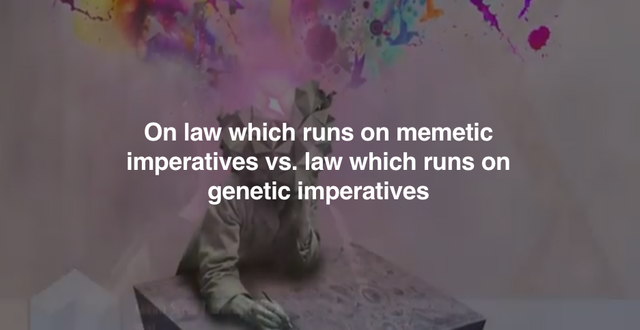On Law Which Runs on Memetic Imperatives Vs. Law Which Runs on Genetic Imperatives

“If it’s work, we try to figure out how to do less. And if it’s art, we try to figure out how to do more. “
– Seth Godin, Stop Stealing Dreams, TED, 2012
Eusociality and the evolution of legal systems
Human behavior is a product of both internal and external mediation. We evolved as social creatures, and our brains are adept at writing rules that mediate how we operate together. Our ability to write laws, and to replicate those laws, is very much what it means to be human, and the basis for how cultures evolve.
The legal systems we create inform and mediate the way we behave, in constant feedback with our internal laws. There is a seamless continuity between internal mediation and external mediation, the two work together, and this duality is what it means to be human, we are social creatures, both individuals and collectives at the same time.
Law as a mediating system
Law could be defined as a technological extension of the human brain’s ability to co-ordinate and form organization with other brains.(2) Industrial tools extend our muscles, digital tools extend our minds, and law as a tool extends the ways in which we can organize as a society.
Laws facilitate package transport of memes, and co-ordinates action across multiple brains. (3) The human brain has a memory limit known as dunbar’s number, pre-technology meme pools do not scale beyond 150 individuals. Technology like writing, currency and legal code, religions, made it possible to co-ordinate at scales beyond dunbar’s number. (4)
Memes co-opt genetic imperatives such as food, sex, territory and dominance, and form the basis of a priori prejudice or predispositions that we call cultural traits. Sense of right and wrong, how justice should be carried out — all these are programmed through meme-replication.
Laws co-ordinate action through attention networks. They tap into genetic imperatives such as territory, or fear, which then direct attention to the memeplex which codes for the law, and amplifies its action, and its effect on other resident memes. (3)
Laws are protocols that govern the spread of memes, and the infusion of memes into brains. Moral law as a protocol is enforced through fear using threat of violence.
Laws are shared mediation
Laws are memes which colonize the mind of groups of brains, and elicit action. They do so through hijacking resident memes, which in turn co-opt genetic imperatives.
Laws only work on brains which are pre-configured for them.
Laws connect networks of brains into larger organization.
Coercive laws and voluntary laws
Law can be divided into two types of law: voluntary law, and coercive law. Voluntary law is when a law is agreed upon, because it makes life simpler for all parties involved, and is something desirable. Coercive law is when a law is forced upon someone who has not agreed to the law. (1)
In coercive law, genetic imperatives dominate, while in voluntary law, memetic imperatives are the dominant enforcement. Dominance for example is a genetic imperative which works through the serotonin system to regulate social status, where decreased social status leads to anhedonia and absence of reward.
Internal mediation meets legal mediation
The word legal derives from loyal, and the human brain is designed to select laws that are loyal to the self, not to the super-organism of the state. Voluntary law easily integrates with the internal state of an individual, and the two work together to extend the capacity of the individual. Coercive law does not integrate at all with inner mediation, and is instead constantly fought off the way a body would reject an implant.
Moral law because cheaper
A rule of thumb that I’ve used is that legal machinery is expensive, and so, we have used moral law because it has been too expensive to build a universal private law infrastructure.
Nina Kilbride talks about how the web 3.0, the “legal web” what could also be called “incentive networks” (5) enables global access to private law which has previously been limited to the rich because of the high costs of maintaining a pre-crypto private law infrastructure.
“Done well, smart contracts will unlock for everyday users the wonders of private law previously only available to the rich. “ – Nina Kilbride
This will massively improve social organization, using “Social Technology” as Zachary Caceres calls it.
Incentives, genetic and memetic imperatives
Examples of genetic imperatives are food, sex, dominance, territory.
Examples of memetic imperatives are intelligence and knowledge and creativity and art and experience and novelty and technology.
Upgrading law to run on memetic imperatives
Law which runs on memetic imperatives does not scale using human-based trust-systems, there is not enough state-machine capacity as it runs on mutational human hardware. With the advent of technology-based trust-systems, there are enough resources for a legal system which runs on memetic imperatives, intelligence.
On basic income and hyper-intelligence
Universal basic income is a law which would improve the mind’s ability to build “navigational charts”, and improve its ability to select laws that are beneficial to its dreams and desires and to the self.
Cultural memes naturally co-opt genetic imperatives for food, sex and dominance and form mutually supporting memeplexes. Basic Income attenuates genetic imperatives like survival and territory, which lets the brain focus more on a cultural perspective, and long-term planning, allowing a different form of ideas to colonize the mind.
Basic income will amplify our collective intelligence in ways so that we can be high-functioning all the time. People are not high-functioning, most people barely scrape by. Basic income will do for neural information — memes — what the TCP/IP protocol did for digital information. That’s the pattern we’re dealing with — Resilience at the level of ideas.





